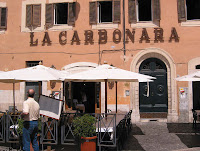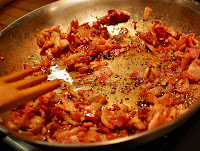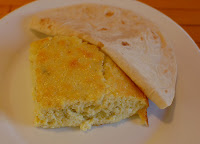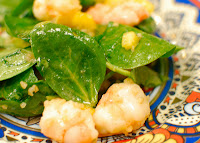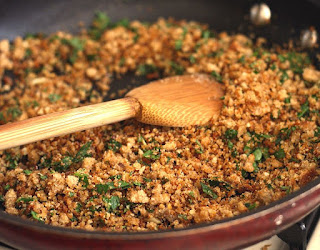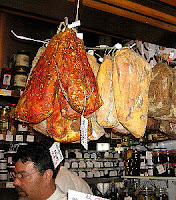 Guanciale is a traditional and ancient Italian specialty of Lazio and Umbria. It is not uncommon to see triangular pieces of meat hanging to dry in shops and cellars throughout the countryside of these regions, though nowadays other regions in Italy are producing guanciale and achieving very good results. In fact, La Quercia in Norwalk, Iowa is producing guanciale using traditional Italians methods here in the U.S. While we have found guanciale in specialty food stores like Dean & Deluca in New York, pancetta or uncured bacon are very good substitutes which are more readily available. We add 1-2 teaspoons black pepper along with adding a few juniper berries to the pan while cooking, (removing them before use in recipes) to approximate the more herbal flavor of guanciale.
Guanciale is a traditional and ancient Italian specialty of Lazio and Umbria. It is not uncommon to see triangular pieces of meat hanging to dry in shops and cellars throughout the countryside of these regions, though nowadays other regions in Italy are producing guanciale and achieving very good results. In fact, La Quercia in Norwalk, Iowa is producing guanciale using traditional Italians methods here in the U.S. While we have found guanciale in specialty food stores like Dean & Deluca in New York, pancetta or uncured bacon are very good substitutes which are more readily available. We add 1-2 teaspoons black pepper along with adding a few juniper berries to the pan while cooking, (removing them before use in recipes) to approximate the more herbal flavor of guanciale.
Friday, February 25, 2011
Guanciale - Italy's Cheeky Treat
Guanciale is named for guancia which is the Italian word for “cheek.” Guanciale is the unsmoked, salt-cured, and seasoned meat derived from the jowls (or cheeks) of the pig. Guanciale often has a couple of streaks of lean pink meat and is surrounded by a delicate, sweet-tasting fat. It’s a real delicacy—a bit stronger than pancetta, with a fuller flavor. For centuries, guanciale was an important part of the farm workers’ outdoor meal in the fields, eaten sparingly with bread. A little slice of guanciale along with Pecorino Romano, some bread, and a jug of wine would have cheered up even the most tired peasant.
 Guanciale is a traditional and ancient Italian specialty of Lazio and Umbria. It is not uncommon to see triangular pieces of meat hanging to dry in shops and cellars throughout the countryside of these regions, though nowadays other regions in Italy are producing guanciale and achieving very good results. In fact, La Quercia in Norwalk, Iowa is producing guanciale using traditional Italians methods here in the U.S. While we have found guanciale in specialty food stores like Dean & Deluca in New York, pancetta or uncured bacon are very good substitutes which are more readily available. We add 1-2 teaspoons black pepper along with adding a few juniper berries to the pan while cooking, (removing them before use in recipes) to approximate the more herbal flavor of guanciale.
Guanciale is a traditional and ancient Italian specialty of Lazio and Umbria. It is not uncommon to see triangular pieces of meat hanging to dry in shops and cellars throughout the countryside of these regions, though nowadays other regions in Italy are producing guanciale and achieving very good results. In fact, La Quercia in Norwalk, Iowa is producing guanciale using traditional Italians methods here in the U.S. While we have found guanciale in specialty food stores like Dean & Deluca in New York, pancetta or uncured bacon are very good substitutes which are more readily available. We add 1-2 teaspoons black pepper along with adding a few juniper berries to the pan while cooking, (removing them before use in recipes) to approximate the more herbal flavor of guanciale.
 Guanciale is a traditional and ancient Italian specialty of Lazio and Umbria. It is not uncommon to see triangular pieces of meat hanging to dry in shops and cellars throughout the countryside of these regions, though nowadays other regions in Italy are producing guanciale and achieving very good results. In fact, La Quercia in Norwalk, Iowa is producing guanciale using traditional Italians methods here in the U.S. While we have found guanciale in specialty food stores like Dean & Deluca in New York, pancetta or uncured bacon are very good substitutes which are more readily available. We add 1-2 teaspoons black pepper along with adding a few juniper berries to the pan while cooking, (removing them before use in recipes) to approximate the more herbal flavor of guanciale.
Guanciale is a traditional and ancient Italian specialty of Lazio and Umbria. It is not uncommon to see triangular pieces of meat hanging to dry in shops and cellars throughout the countryside of these regions, though nowadays other regions in Italy are producing guanciale and achieving very good results. In fact, La Quercia in Norwalk, Iowa is producing guanciale using traditional Italians methods here in the U.S. While we have found guanciale in specialty food stores like Dean & Deluca in New York, pancetta or uncured bacon are very good substitutes which are more readily available. We add 1-2 teaspoons black pepper along with adding a few juniper berries to the pan while cooking, (removing them before use in recipes) to approximate the more herbal flavor of guanciale.
Yum
Ridiculously Delicious Fettuccine Alla Carbonara
When Nic ordered Fettuccine alla Carbonara at a restaurant of the same name “La Carbonara” in Campo de' Fiori in Rome, this immediately became a favorite Romeo recipe. Gathering fresh ingredients from the local “mercato”, Dom made this dish almost daily in our rented apartment near the Pantheon. We still contend that the fresh Italian ingredients made an enormous difference in the taste of this dish. Carbonara (charcoal maker's pasta) is one of the most classical of all pasta dishes and is artfully simple with very basic ingredients: pasta, eggs, cured meat and cheese. The combination of textures and flavors results in one of the most complex and satisfying dishes you will ever eat. For this reason we chose this dish as our entry in the “Ridiculously Delicious Challenge.”
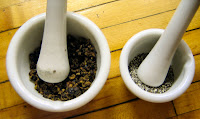 Traditional Roman recipes for Carbonara call for guanciale, but because guanciale is not readily available, pancetta can be used as a substitute. Guanciale is made from pork cheek, while pancetta is made from the pork belly. Though the seasoning and aging of guanciale are very similar to pancetta, the cheek meat yields a denser and more intense pork flavor and texture. To imitate the more elemental notes of guanciale, we decided to use two of our “ridiculously delicious” ingredients from Marx Foods: juniper berries (crushed) and “Grains of Paradise” (ground). We also made a call to our friend Beth to get freshly laid eggs for the pasta and the sauce.
Traditional Roman recipes for Carbonara call for guanciale, but because guanciale is not readily available, pancetta can be used as a substitute. Guanciale is made from pork cheek, while pancetta is made from the pork belly. Though the seasoning and aging of guanciale are very similar to pancetta, the cheek meat yields a denser and more intense pork flavor and texture. To imitate the more elemental notes of guanciale, we decided to use two of our “ridiculously delicious” ingredients from Marx Foods: juniper berries (crushed) and “Grains of Paradise” (ground). We also made a call to our friend Beth to get freshly laid eggs for the pasta and the sauce.
To make this dish we started out by making fresh homemade fettuccine noodles. Click here to see how we did it!
Then we heated olive oil in a skillet over medium-high heat, added the pancetta, juniper berries and “Grains of Paradise” and sautéed them together until the pancetta was warm crisp and brown which took about 5-6 minutes. Dom put the eggs, egg yolks, and ¼ cup water into a small bowl and beat them together with a fork, and then it set aside. We cooked the fettuccine in a large pot of boiling salted water until it was al dente, drained it (reserving about 2 cups of the boiling water) and then placed it a large mixing bowl.
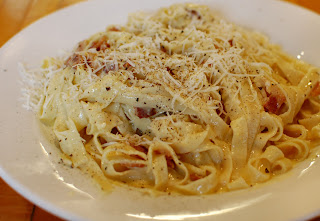 Using 2 large wooden spoons, we mixed the eggs, seasoned pancetta with the pan scrapings, and ¼ cup each of the Parmesan and Pecorino into fettuccine. If the sauce is too thick (or gloppy,) you can some of the reserve pasta water to thin the sauce. We served the Carbonara in big bowls sprinkled with the remaining grated cheeses and freshly ground black pepper on top. We sat down to a decadent meal as a family. We all noticed the earthy aroma of the juniper berries and the unique peppery flavor of the “Grains of Paradise.” It was indeed a ridiculously delicious dinner!
Using 2 large wooden spoons, we mixed the eggs, seasoned pancetta with the pan scrapings, and ¼ cup each of the Parmesan and Pecorino into fettuccine. If the sauce is too thick (or gloppy,) you can some of the reserve pasta water to thin the sauce. We served the Carbonara in big bowls sprinkled with the remaining grated cheeses and freshly ground black pepper on top. We sat down to a decadent meal as a family. We all noticed the earthy aroma of the juniper berries and the unique peppery flavor of the “Grains of Paradise.” It was indeed a ridiculously delicious dinner!
 Traditional Roman recipes for Carbonara call for guanciale, but because guanciale is not readily available, pancetta can be used as a substitute. Guanciale is made from pork cheek, while pancetta is made from the pork belly. Though the seasoning and aging of guanciale are very similar to pancetta, the cheek meat yields a denser and more intense pork flavor and texture. To imitate the more elemental notes of guanciale, we decided to use two of our “ridiculously delicious” ingredients from Marx Foods: juniper berries (crushed) and “Grains of Paradise” (ground). We also made a call to our friend Beth to get freshly laid eggs for the pasta and the sauce.
Traditional Roman recipes for Carbonara call for guanciale, but because guanciale is not readily available, pancetta can be used as a substitute. Guanciale is made from pork cheek, while pancetta is made from the pork belly. Though the seasoning and aging of guanciale are very similar to pancetta, the cheek meat yields a denser and more intense pork flavor and texture. To imitate the more elemental notes of guanciale, we decided to use two of our “ridiculously delicious” ingredients from Marx Foods: juniper berries (crushed) and “Grains of Paradise” (ground). We also made a call to our friend Beth to get freshly laid eggs for the pasta and the sauce.- 1 lb. fresh fettuccine
- 1 tablespoon extra-virgin olive oil
- 5 oz. pancetta, cut into ¼” cubes
- ½ teaspoon juniper berries (crushed with a mortar & pestle)
- ½ teaspoon “Grains of Paradise,” freshly ground (optional)
- 2 eggs plus 2 egg yolks (organic eggs taste best)
- ½ cup freshly grated Parmigiano-Reggiano
- ½ cup freshly grated Pecorino-Romano
- Freshly ground Tellicherry peppercorns (also available from Marx Foods!)
To make this dish we started out by making fresh homemade fettuccine noodles. Click here to see how we did it!
Then we heated olive oil in a skillet over medium-high heat, added the pancetta, juniper berries and “Grains of Paradise” and sautéed them together until the pancetta was warm crisp and brown which took about 5-6 minutes. Dom put the eggs, egg yolks, and ¼ cup water into a small bowl and beat them together with a fork, and then it set aside. We cooked the fettuccine in a large pot of boiling salted water until it was al dente, drained it (reserving about 2 cups of the boiling water) and then placed it a large mixing bowl.
 Using 2 large wooden spoons, we mixed the eggs, seasoned pancetta with the pan scrapings, and ¼ cup each of the Parmesan and Pecorino into fettuccine. If the sauce is too thick (or gloppy,) you can some of the reserve pasta water to thin the sauce. We served the Carbonara in big bowls sprinkled with the remaining grated cheeses and freshly ground black pepper on top. We sat down to a decadent meal as a family. We all noticed the earthy aroma of the juniper berries and the unique peppery flavor of the “Grains of Paradise.” It was indeed a ridiculously delicious dinner!
Using 2 large wooden spoons, we mixed the eggs, seasoned pancetta with the pan scrapings, and ¼ cup each of the Parmesan and Pecorino into fettuccine. If the sauce is too thick (or gloppy,) you can some of the reserve pasta water to thin the sauce. We served the Carbonara in big bowls sprinkled with the remaining grated cheeses and freshly ground black pepper on top. We sat down to a decadent meal as a family. We all noticed the earthy aroma of the juniper berries and the unique peppery flavor of the “Grains of Paradise.” It was indeed a ridiculously delicious dinner!
Yum
Saturday, February 19, 2011
Chili Cheese Egg Bake
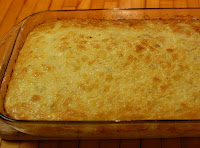 This casserole-style preparation for eggs is easy to make and makes a very impressive addition to any breakfast or brunch menu. It travels well for office parties or pot luck soirées. It is delicate, cheesy and mildly picante, but be careful it stays hot for a good while after being served. This versatile dish reheats well and can even be frozen, then reheated by covering with foil.
This casserole-style preparation for eggs is easy to make and makes a very impressive addition to any breakfast or brunch menu. It travels well for office parties or pot luck soirées. It is delicate, cheesy and mildly picante, but be careful it stays hot for a good while after being served. This versatile dish reheats well and can even be frozen, then reheated by covering with foil.- ½ cup butter
- 10 eggs
- ½ cup flour
- 1 teaspoon baking powder
- dash of salt
- 1 8-ounce can chopped mild green chilies
- 2 cups (16 ounces) cottage cheese
- 1 lb. (4 cups) Monterey Jack cheese, shredded
Melt butter in a 9 x 13 inch baking pan and set aside. In a large mixing bowl beat eggs and add flour, baking powder and salt and mix well. Add melted butter, leaving the pan buttered. Add chilies and cheese. Mix together and pour into baking pan. Bake uncovered at 350o degrees for 45 to 60 minutes. Test for doneness with a knife. Be sure eggs are set and knife blade comes out clean when inserted in center. Cut into squares while hot, but allow to cool slightly before removing from pan. Serve with toast, biscuits or warm tortillas and sliced tomatoes (or a spicy Bloody Mary) for a wonderful start to your weekend!
Yum
Sunday, February 13, 2011
Hummus - Tel Aviv’s Soul Food
- 2 cups dried chickpeas, (soaked overnight in cold water)
- 1/3 cup ice cubes
- 1/3 cup lemon juice
- 1/2 cup tahini paste
- 2 garlic cloves, crushed
- 1 teaspoon ground cumin
- Salt
 Place the chickpeas in a large saucepan with cold water to cover, bring to the boil and cook over a medium heat for one hour until very tender. Drain the peas and reserve 1/4 cup of the cooking liquid, and then transfer the chickpeas, reserved cooking liquid and ice cubes to a food processor. Add the lemon juice, tahini, garlic and cumin, and then pulse until smooth. Season to taste and serve with your favorite flatbread or crudité and imagine a refreshing sea breeze!
Place the chickpeas in a large saucepan with cold water to cover, bring to the boil and cook over a medium heat for one hour until very tender. Drain the peas and reserve 1/4 cup of the cooking liquid, and then transfer the chickpeas, reserved cooking liquid and ice cubes to a food processor. Add the lemon juice, tahini, garlic and cumin, and then pulse until smooth. Season to taste and serve with your favorite flatbread or crudité and imagine a refreshing sea breeze!
Yum
Friday, February 11, 2011
Guest Blogger and Guest Chef
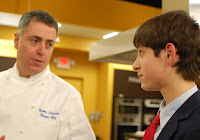 contributed by Sonny Romeo
contributed by Sonny RomeoThe crackling and sizzling on the stove gave way to the great Ronen Skinezes, Executive Chef of Tel Aviv’s Manta Ray restaurant, last Thursday. After much anticipation, the Chef held his cooking class at Ansley Mall Cook’s Warehouse. “It was different,” said 12-year-old Zoie Brown, “What we tasted tonight wasn’t something you would taste at McDonald’s or Wendy’s.” And it was different. We sampled everything from Eggplant Mousse to strawberries with whipped cream and Doritos.
“Our entire cuisine is different,” Chef Skinezes admitted. “We use a lot of eggplant and other vegetables, and it is challenging for a lot of our different recipes to be kosher. A lot of European cuisine requires food be shipped from outside sources but we are resourceful and use what we have available to us.” Yet it wasn’t all about the food; “In light of all the recent events surrounding Israel, we feel it is our job to share our culture. You all hear the bad press, but we want Americans to know that Israel is a wonderful place to live and to visit,” said Einat Shaul of the Israeli Consulate here in Atlanta.
Chef Skinezes prepared one dish that was a great example of Israeli fare using lots of Mediterranean vegetables and fish. The finished dish was very light and fresh tasting. The preserved lemon added a unique flavor.
Grouper Fillet with Chickpeas and Artichokes
- 3/4 cup chickpeas, soaked overnight in water
- 6 artichoke bottoms
- Kosher salt and pepper
- 2 tablespoons lemon juice
- 1 3/4 pounds grouper fillet
- 1/2 cup olive oil
- 1 teaspoon garlic, minced
- 1 cup vegetable stock
- 1/2 cup tomatoes, diced into small cubes
- 1 teaspoon preserved lemon, chopped
- 4 tablespoons butter
- 1/4 cup parsley, chopped
- 1 tablespoon sesame seeds, toasted

Preheat the oven to 400 degrees F. Drain the chickpeas, transfer into a saucepan and cover with water. Bring to a boil and cook over medium heat until the chickpeas are soft. Remove from the heat and set aside.
Slice the artichoke bottoms into quarters. Place in a separate saucepan and cover with water. Add kosher salt and lemon juice, bring to a boil and cook over medium heat for 5 minutes. Drain and cool under running water.
Heat 1/4 cup of olive oil in a heavy skillet. Season the fish fillets with salt and pepper, and then place the fillets in the pan, skin side down, and sear for 2 minutes or until the skin is brown and crispy. Turn the fish and sear for another 30 seconds. Transfer the fish fillets to an oiled baking dish and bake in the preheated oven for 5-6 minutes.
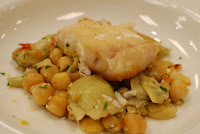 Meanwhile heat the remaining olive oil in a saucepan or a sauté pan. Add the chickpeas, artichokes, and garlic and stir for a minute. Add the vegetable stock and bring to a boil. Add the tomatoes, preserved lemon, butter, salt and pepper and cook until the butter melts and the sauce is reduced. Add the parsley and remove from the flame.
Meanwhile heat the remaining olive oil in a saucepan or a sauté pan. Add the chickpeas, artichokes, and garlic and stir for a minute. Add the vegetable stock and bring to a boil. Add the tomatoes, preserved lemon, butter, salt and pepper and cook until the butter melts and the sauce is reduced. Add the parsley and remove from the flame.To serve, place the chickpea and artichoke stew on serving plates. Place the fish on top, drizzle with olive oil, and sprinkle with sesame seeds.
Yum
Thursday, February 10, 2011
An Evening of Authentic Israeli Cuisine
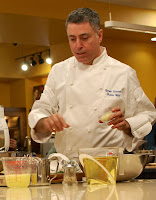 Sonny and I were treated to the most amazing evening of Israeli hospitality. Chef Ronen Skinezes of Manta Ray restaurant in Tel Aviv, members of the Israeli Consulate General of Israel to the Southeast, and The Cook’s Warehouse hosted a meal of Authentic Israeli cuisine which completely reversed our preconceived idea of Middle Eastern food. Chef Skinezes is visiting Atlanta to present a signature Israeli dish on opening night of The Atlanta Jewish Film Festival at the Fox Theatre.
Sonny and I were treated to the most amazing evening of Israeli hospitality. Chef Ronen Skinezes of Manta Ray restaurant in Tel Aviv, members of the Israeli Consulate General of Israel to the Southeast, and The Cook’s Warehouse hosted a meal of Authentic Israeli cuisine which completely reversed our preconceived idea of Middle Eastern food. Chef Skinezes is visiting Atlanta to present a signature Israeli dish on opening night of The Atlanta Jewish Film Festival at the Fox Theatre.“Most people think Israeli meals consist only of traditional kosher dishes such as knishes, Gefilte fish, and matzah,” stated Joe Diaz, Director of the Southern Region of the Israel Ministry of Tourism. “It is actually hard to find a kosher restaurant in Tel Aviv,” continued Einat Shaul of the Israeli Consulate General of Israel to the Southeast. A pre-dinner peak into the kitchen at all the fresh vegetables and fish were a good indication that we were indeed in for a treat. Chef Skinzes started the evening demonstrating how to make Eggplant Mousse, a simple and aromatic dish of grilled eggplant,
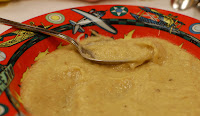 lemon juice, oil and garlic pureed to perfection and served with whole wheat naan, which is a type of flatbread popular in the Middle East. The chef, who looked incredibly relaxed and confident even after a week of travel and cooking demonstrations, answered questions and gave cooking and shopping tips as he stirred the components in his pan. “When choosing an eggplant it should feel light, not heavy,” he recommended.
lemon juice, oil and garlic pureed to perfection and served with whole wheat naan, which is a type of flatbread popular in the Middle East. The chef, who looked incredibly relaxed and confident even after a week of travel and cooking demonstrations, answered questions and gave cooking and shopping tips as he stirred the components in his pan. “When choosing an eggplant it should feel light, not heavy,” he recommended.The mousse appetizer was followed by a fresh spinach salad with bulgur wheat, chopped mango, sautéed shrimp tossed with a lemon-mint dressing. Again a simple and elegant combination of textures and flavors. Two Isreali white wine pairings were sampled during the meal which were very impressive as well. Chef Skinezes prepared a main course of pan-fried grouper served on a bed of artichokes, chick peas and tomatoes. He reminded diners to always salt the fish before cooking as the grouper browned in his pan. The end result was a succulent dish of perfectly cooked fish complimented by a light Mediterranean medley of vegetables.
 Fresh strawberries and whipped cream were presented for dessert. We were all intrigued by an orange-ish “crunch” that was sprinkled over the berries which added a unique and mysterious consistency and flavor. Chef gave a mischievous smile as he held up a bag of nacho cheese Doritos saying teasingly, “It is our Israeli secret ingredient.” As the 20+ diners left for the evening, there was a sincere feeling of contentment and jovial utterings of תודה (pronounced toh-DAH) thanking the Chef and his staff and our hosts for a marvelous evening, our perceptions of Israeli cuisine completely transformed!
Fresh strawberries and whipped cream were presented for dessert. We were all intrigued by an orange-ish “crunch” that was sprinkled over the berries which added a unique and mysterious consistency and flavor. Chef gave a mischievous smile as he held up a bag of nacho cheese Doritos saying teasingly, “It is our Israeli secret ingredient.” As the 20+ diners left for the evening, there was a sincere feeling of contentment and jovial utterings of תודה (pronounced toh-DAH) thanking the Chef and his staff and our hosts for a marvelous evening, our perceptions of Israeli cuisine completely transformed!
Yum
Monday, February 7, 2011
Ridiculously Delicious Entry!
If we were to win the Marx Foods’ Ridiculously Delicious Challenge, we would choose to receive the Specialty burger sampler, ground Kangaroo meat and the Wild Mushroom sampler. We would then embark on a culinary journey across the globe via a menu of original and unique sliders and mini burgers. The menu might look something like this:
“Dalai Llama” sliders:
Llama burgers with “World Peace” (whirled peas) puree, Tibetan turnip slaw, Holy (Swiss) cheese and served on Himalayan Flatbread.
“Show your Lakers’ Colors/Tribute to Kobe” beef sliders:
Kobe beef patties grilled to perfection with shredded Monterrey cheese, and a Yellow Foot mushroom sauce on California sourdough rolls and served with purple potato pan fries.
“Home on the Range” Bison mini burgers:
Hand-formed Bison burgers with crispy smoked bacon strips and “Dude Ranch” dressing on griddled Indian-corn, Johnny-Cake buns served with a toothpick skewer to keep them “stable” and home fries.
“The Deerhunter” Venison sliders:
Venison burgers with sautéed Black Trumpet mushrooms, Huntsman cheese and wild nettle mayonnaise served on Buckwheat buns.
“From Russia with Love” Yak mini burgers:
Mini burgers made from ground Yak with roasted beet salad, pickled onion relish and horseradish sauce served on pumpernickel rolls with Siberian potato cakes.
“Down Under” Kangaroo sliders:
Ground kangaroo meat formed into sliders, cooked on the barbie served on Outback buns with a Hedgehog mushroom and Tasmanian pan gravy, and an Australian blue cheese crumble.
“Dalai Llama” sliders:
Llama burgers with “World Peace” (whirled peas) puree, Tibetan turnip slaw, Holy (Swiss) cheese and served on Himalayan Flatbread.
“Show your Lakers’ Colors/Tribute to Kobe” beef sliders:
Kobe beef patties grilled to perfection with shredded Monterrey cheese, and a Yellow Foot mushroom sauce on California sourdough rolls and served with purple potato pan fries.
“Home on the Range” Bison mini burgers:
Hand-formed Bison burgers with crispy smoked bacon strips and “Dude Ranch” dressing on griddled Indian-corn, Johnny-Cake buns served with a toothpick skewer to keep them “stable” and home fries.
“The Deerhunter” Venison sliders:
Venison burgers with sautéed Black Trumpet mushrooms, Huntsman cheese and wild nettle mayonnaise served on Buckwheat buns.
“From Russia with Love” Yak mini burgers:
Mini burgers made from ground Yak with roasted beet salad, pickled onion relish and horseradish sauce served on pumpernickel rolls with Siberian potato cakes.
“Down Under” Kangaroo sliders:
Ground kangaroo meat formed into sliders, cooked on the barbie served on Outback buns with a Hedgehog mushroom and Tasmanian pan gravy, and an Australian blue cheese crumble.
Yum
Friday, February 4, 2011
Savory Pork Saltimbocca
Romans call this recipe for pork or veal, saltimbocca, or "jump in the mouth" for its savory appeal. This simple preparation emphasizes the flavors of the pork and prosciutto. A modest plate of spaghetti aioli and a nice salad of mesculin mix make for a delicious family meal.
Place a sage leaf on the top of each pork cutlet then wrap each with a thin slice of prosciutto. Set aside while you heat oil in a large skillet over medium heat until hot but not smoking.
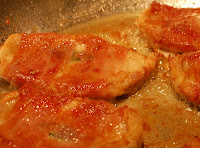 Place flour in a shallow dish and lightly dredge each prepared cutlet in the flour. Gently lay the floured cutlet in the heated olive oil in a single layer. You will probably need to work in batches. Sauté cutlets until prosciutto is slightly browned and crisp on edges and pork is lightly browned, about 1-2 minutes. Turn and brown other side for 1 minute. As meat is cooked, transfer to a warm platter.
Place flour in a shallow dish and lightly dredge each prepared cutlet in the flour. Gently lay the floured cutlet in the heated olive oil in a single layer. You will probably need to work in batches. Sauté cutlets until prosciutto is slightly browned and crisp on edges and pork is lightly browned, about 1-2 minutes. Turn and brown other side for 1 minute. As meat is cooked, transfer to a warm platter.
Once all the saltimbocca cutlets have been cooked, pour off and discard oil/fat from the skillet, and return the skillet to medium-high heat. Add wine, and cook, scraping browned bits stuck to bottom of skillet (these are the best part!) Once alcohol has evaporated; about 1 minute, add stock and drain accumulated juices from platter and reduce by three-quarters. This should take about 10 minutes, then whisk in butter.

Return the saltimbocca to skillet just long enough to heat through, and then transfer to a serving platter and spoon pan sauce over the top. A simple plate of spaghetti aioli and a nice salad of mesculin mix make for a delicious family meal.
- 12 small pork cutlets
- 12 thinly-sliced prosciutto
- 12 large fresh sage leaves
- ½ cup flour
- ¼ cup extra-virgin olive oil
- ¼ cup dry white wine
- 1 cup chicken stock
- 3 tablespoons butter, in pieces
Place a sage leaf on the top of each pork cutlet then wrap each with a thin slice of prosciutto. Set aside while you heat oil in a large skillet over medium heat until hot but not smoking.
 Place flour in a shallow dish and lightly dredge each prepared cutlet in the flour. Gently lay the floured cutlet in the heated olive oil in a single layer. You will probably need to work in batches. Sauté cutlets until prosciutto is slightly browned and crisp on edges and pork is lightly browned, about 1-2 minutes. Turn and brown other side for 1 minute. As meat is cooked, transfer to a warm platter.
Place flour in a shallow dish and lightly dredge each prepared cutlet in the flour. Gently lay the floured cutlet in the heated olive oil in a single layer. You will probably need to work in batches. Sauté cutlets until prosciutto is slightly browned and crisp on edges and pork is lightly browned, about 1-2 minutes. Turn and brown other side for 1 minute. As meat is cooked, transfer to a warm platter. Once all the saltimbocca cutlets have been cooked, pour off and discard oil/fat from the skillet, and return the skillet to medium-high heat. Add wine, and cook, scraping browned bits stuck to bottom of skillet (these are the best part!) Once alcohol has evaporated; about 1 minute, add stock and drain accumulated juices from platter and reduce by three-quarters. This should take about 10 minutes, then whisk in butter.

Return the saltimbocca to skillet just long enough to heat through, and then transfer to a serving platter and spoon pan sauce over the top. A simple plate of spaghetti aioli and a nice salad of mesculin mix make for a delicious family meal.
Yum
Tuesday, February 1, 2011
Ode to Mollica (Sautéed Bread Crumbs)
Okay, so I am not really prepared to write 10-line stanzas of iambic verse using an ababcdecde rhyming scheme, but the virtues of bread crumbs toasted in extra-virgin olive oil are many and varied.
Originally used as an inexpensive substitute for cheese, "Mollica di pane," as it is called in Italy, is a traditional garnish that can elevate even the simplest dishes. Served on creamy pasta dishes, sautéed vegetables, or broiled fish, mollica (also known as pangrattato) lends a delightful texture and flavor nuance. Mixed with less savory flavors like lemon zest or mint, these delightful crumbs can even be used as a topping for gelato.
1 cup fine freshly ground bread crumbs (or Panko)
2 tablespoons extra-virgin olive oil (first cold pressed is best)
Salt, pepper, herbs (or even peperoni cruschi,) to your taste
Heat olive oil over medium heat and when the oil is hot; add the bread crumbs, tossing gently until they are evenly coated. Sauté the crumbs until they are golden brown. This will probably take longer than you expect. Allow the crumbs to cool, as they cool they become even crunchier. Note that super fine bread crumbs (most often purchased in a can from the grocery store) will not work with this technique as they will turn into a paste or dough rather than a crunchy delicacy. We place the mollica in a bowl on the table for diners to sprinkle to their heart's desire. For the record, the bowl is always empty by meal’s end!
Originally used as an inexpensive substitute for cheese, "Mollica di pane," as it is called in Italy, is a traditional garnish that can elevate even the simplest dishes. Served on creamy pasta dishes, sautéed vegetables, or broiled fish, mollica (also known as pangrattato) lends a delightful texture and flavor nuance. Mixed with less savory flavors like lemon zest or mint, these delightful crumbs can even be used as a topping for gelato.
1 cup fine freshly ground bread crumbs (or Panko)
2 tablespoons extra-virgin olive oil (first cold pressed is best)
Salt, pepper, herbs (or even peperoni cruschi,) to your taste
Heat olive oil over medium heat and when the oil is hot; add the bread crumbs, tossing gently until they are evenly coated. Sauté the crumbs until they are golden brown. This will probably take longer than you expect. Allow the crumbs to cool, as they cool they become even crunchier. Note that super fine bread crumbs (most often purchased in a can from the grocery store) will not work with this technique as they will turn into a paste or dough rather than a crunchy delicacy. We place the mollica in a bowl on the table for diners to sprinkle to their heart's desire. For the record, the bowl is always empty by meal’s end!
Yum
Subscribe to:
Posts (Atom)
Powered by Blogger.
